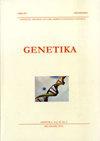石榴(Punica granatum L.)体细胞无性系变异:ISSR和细胞学证据
4区 农林科学
Q3 Agricultural and Biological Sciences
引用次数: 1
摘要
组织培养技术的新进展导致了园艺作物的几种再生的离体繁殖。在植物组织培养过程中发生的体细胞无性系变异是这类作物诱导新的遗传变异的潜在来源。已有几种方法被用来确定体细胞无性系变异的发生。石榴植物能适应各种环境条件,在各种土壤和气候条件下都能生长良好。石榴品种Zagheh主要种植在伊朗卡尚市的Esfehan州。本研究旨在探讨扎格(Zagheh)品种组织培养再生植株发生体细胞无性系变异的可能性,并为其发生提供形态学、细胞学和分子生物学依据。选择石榴的节段进行离体繁殖。外植体在MS基培养基上培养。我们对收集到的繁殖株进行了分子(ISSR)和核学研究。在本研究中,我们观察了组织培养再生植株的形态(茎长、分枝长、节间长、叶和根长、分枝和根数)和遗传特征的变化。第三代再生植株在ISSR标记上与原植株存在差异。我们观察到经常出现不同染色体数目的细胞,从正常的二倍体2n = 2x = 16到四倍体2n = 32染色体数目不等。本文章由计算机程序翻译,如有差异,请以英文原文为准。
Somaclonal variation in pomegranate (Punica granatum L.): ISSR and cytological evidences
New advancements in tissue culture techniques have resulted in vitro propagation of several regenerations of horticultural crops. The somaclonal variation which occurs during plant tissue culture is a potential source for inducing new genetic variability in such crops. Several approaches have been utilized to ascertain the occurrence of somaclonal variation. The pomegranate plant can adapt to various environmental conditions and grow well in different kinds of soil and climate. Pomegranate Zagheh cultivar is mainly cultivated in the state of Esfehan, Kashan city in Iran. The present study was performed to investigate the potential occurrence of somaclonal variation in tissue culture regenerated plants of the cultivar Zagheh and provide morphological, cytological and molecular evidences for its occurrence. Nodal segments were chosen for the in vitro propagation of pomegranate. Explants were cultured on MS basal medium. We carried out both molecular (ISSR) and karyological studies in propagation collected. In the present study, we observed variation in both morphological (length of shoot, branch, internode, leaf and root and number of branch and root) and genetic features of the tissue culture regenerated plants. The regenerated plants of the third sub-culture differed from mother plants in the ISSR marker. We observed frequent occurrence of cells with different chromosome numbers, ranging from normal diploid 2n = 2x = 16 to tetraploid 2n = 32 chromosome number.
求助全文
通过发布文献求助,成功后即可免费获取论文全文。
去求助
来源期刊

Genetika-Belgrade
AGRONOMY-GENETICS & HEREDITY
CiteScore
1.80
自引率
0.00%
发文量
1
审稿时长
6-12 weeks
期刊介绍:
The GENETIKA is dedicated to genetic studies of all organisms including genetics of microorganisms, plant genetics, animal genetics, human genetics, molecular genetics, genomics, functional genomics, plant and animal breeding, population and evolutionary genetics, mutagenesis and genotoxicology and biotechnology.
 求助内容:
求助内容: 应助结果提醒方式:
应助结果提醒方式:


